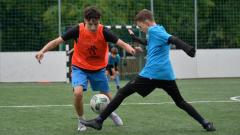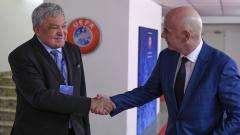UEFA president to attend official opening of Puskás Aréna

UEFA president Aleksander Čeferin will attend Hungary's first match at their new Puskás Aréna on Friday, while also underlining UEFA's commitment to helping develop football at all levels in the country.
15 November will be a momentous occasion for Hungarian football, with the official opening of the Puskás Aréna in Budapest. The stadium, named in honour of the greatest player the country has ever produced, will see Hungary take on Uruguay in a friendly – a repeat of the 1954 FIFA World Cup semi-final which the 'Mighty Magyars' won 4–2.
The Puskás Aréna, set to host four matches at UEFA EURO 2020 next summer, has a capacity of close to 68,000 and tickets for Friday's visit of Uruguay were snapped up in a matter of days.
UEFA president Aleksander Čeferin will be one of the guests of honour for the official inauguration and he is delighted that Budapest now has a stadium that will be one of the finest in Europe.
„I would like to pay tribute to the Hungarian Football Federation and in particular Sándor Csányi, the president, for overseeing the completion of what will be the jewel in Hungarian football's crown for decades to come,” Čeferin said.
„It is fitting that such a magnificent stadium is named after Ferenc Puskás. He was a player before his time, a player who had such outstanding vision and leadership qualities. I never had the opportunity to watch him play live, but his feats in helping Hungary to beat England in 1953 and his four goals for Real Madrid in their 7–3 victory in the [1960] European Cup final against Eintracht Frankfurt have been and will continue to be etched in the memories of football fans for generations.”
The completion of the Puskás Aréna shows a commitment from the Hungarian Football Federation (MLSZ) to improving the country's footballing infrastructure by building new stadiums. Earlier this year, the recently constructed Ferencváros Stadium staged the UEFA Women's Champions League final, while Honvéd, who are also from the Hungarian capital, are planning a new arena too.
Some of these stadiums will be put to use when Hungary co-hosts the 2021 UEFA European Under-21 Championship with Slovenia.
„I am very proud that Budapest and Hungary now has one of the most beautiful and modern football stadiums of the continent. The international matches of the Hungarian national team and the top European club matches will give great inspiration for the next generation of football players,” said MLSZ president Sándor Csányi.
„Fans from Hungary and across Europe will be able to watch matches at the Puskás Aréna next summer; however, it is our aim that in the future, we would like this magnificent stadium to host other major sport events here. I'd like to express my gratitude for UEFA for supporting us throughout the planning phase and for giving us relevant information and experience during the recent years.”
How UEFA supports Hungarian football
Improving infrastructure does not just mean building new stadiums – it is also necessary to invest in the footballers of tomorrow. With this in mind, the MLSZ has been working closely with UEFA to ensure that youngsters have as many opportunities as possible to play football.
While UEFA EURO 2020 will capture the imagination of fans around Hungary and Europe, the tournament will have another significant impact that is less obvious to supporters, with some €775.5m generated by the finals being funnelled into UEFA's HatTrick assistance programme and consequently shared between UEFA's 55 national associations.
The HatTrick scheme began in 2004, based on the simple idea of taking an ample proportion of UEFA European Championship revenue and reinvesting it into football development in three (hence the name) different ways: investment, education and knowledge-sharing. By 2024, HatTrick will have made available a remarkable €2.6bn in support of the member associations.
„HatTrick is a vitally important development programme, which shows that UEFA's commitment to European football runs a lot deeper than its major club and national team competitions,” Čeferin explained. „We consider growth and development an absolute prerequisite to maintain a sustainable and highly successful level of football for everyone.”
The MLSZ used HatTrick funding to build its headquarters in Telki, which opened in 2009, with the infrastructure at the technical centre being updated since; there are also ongoing plans to build a sports hall at the site. Moreover, to give youngsters the chance to play football all year round and on excellent playing surfaces, 20 artificial pitches have been erected around Hungary thanks to HatTrick funds. The programme has also funded 80 mini-pitches at kindergartens across the country, to ensure that children have access to playing football from a young age.
Grassroots development
Getting children to play and enjoy football is a crucial part of UEFA's vision – and the body's new Football in Schools programme, unveiled in Slovenia in September, will take this vision an important step forward.
Over the next four years, UEFA – via HatTrick – will invest €44m in grassroots football in Europe, of which €11m will be dedicated to developing and/or improving schools football. This will be on top of the €150,000 (to rise to €200,000 for the 2020/21) that each national association can receive every year specifically for grassroots activities, in line with the UEFA Grassroots Charter.
Among the numerous objectives of the Football in Schools initiative is the promotion of football as a social and educational tool; to increase the number of registered players by creating links between clubs and local schools; and make football activities integral to children's physical education. The aim is also to train teachers and volunteers to provide quality football lessons, and to boost the number of coaches, in particular female coaches.
„Children are the future of our sport and it is vitally important that we give them every opportunity to play and enjoy football,” said Csányi. „We are delighted to see more and more boys and girls playing the football and we will continue to invest in grassroots development.”
To its credit, the MLSZ has been one step ahead of the game, further developing its own football in schools scheme since 2013, in conjunction with the Hungarian School Sports Federation (HSSF). The programme aims to involve 1.2 million schoolchildren – around 12.5% of the country's total population – with the help of implementing football into the national curriculum as a school subject over the next few years.
The goal is that when the scheme reaches its conclusion, every Hungarian school will have two fully qualified teachers able to run the MLSZ grassroots programme, which will equate to roughly 7,000 teachers nationwide.
The MLSZ is committed to giving – and has taken numerous steps in this direction – youngsters as much access to playing football as possible, as well as enabling them to watch the sport in modern venues. Together with UEFA, the Hungarian football governing body will only intensify these efforts to safeguard the good health of the sport.
A hírkategória további hírei
2026-01-08 12:00:08
Become a Volunteer at the UEFA Champions League Final 2026!
2025-09-29 19:44:06
Nearly 10,000 Hungarian children kick footballs during Grassroots Week
2024-10-09 11:47:54
3,500 children at Grassroots festivals!
2023-04-05 15:42:36












